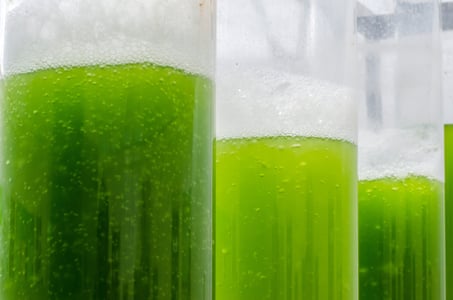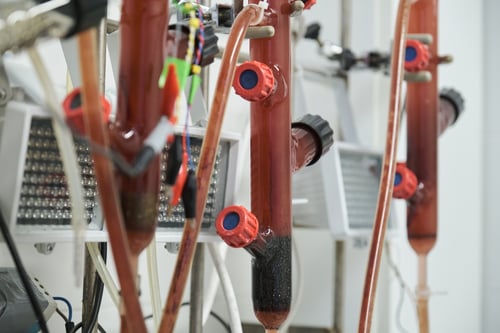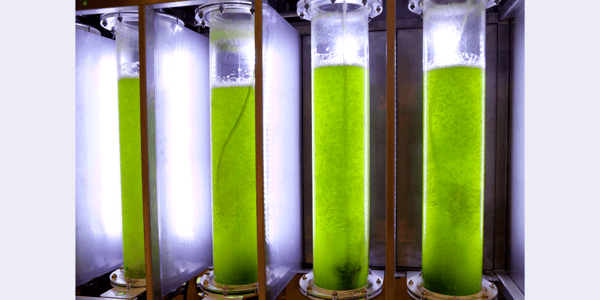Microorganism Spotlight – Phototrophic Organisms

According to their form of nutrition, we can categorize organisms into different groups. While phototrophic organisms use light as their source of energy, chemotrophic organisms receive their energy via the oxidation of inorganic substances. Within these categories, two further groups can be distinguished depending on their carbon source: While photo- or chemoautotrophs fixate CO2 and use this as their carbon source, photo- or chemoheterotrophs need organic substances that were previously produced by other organisms.
These categories can be useful for understanding the diverse ways in which organisms obtain and use energy and nutrients to thrive.
|
Nutrition Type |
Energy Source |
Carbon Source |
|
Photoautotrophs |
Light |
Carbon dioxide |
|
Photoheterotrophs |
Light |
Organic substances |
|
Chemoautotrophs |
Inorganic substances |
Carbon dioxide |
|
Chemoheterotrophs |
Organic substances |
Organic substances |
Table 1: Nutrition types among organisms
The Ecological Importance of Phototrophic Organisms
Phototrophic organisms are essential for maintaining the balance of ecosystems and play a crucial role in the global carbon cycle. By converting light energy into chemical energy, phototrophic organisms produce organic matter that is then consumed by other organisms. This process forms the base of most food chains and supports the growth of all other living things in the ecosystem.
Photosynthetic organisms are also responsible for producing the oxygen that we breathe. Oxygenic photosynthesis has been the primary source of atmospheric oxygen over billions of years. This process has played a critical role in the evolution of life on Earth, as oxygen is required by many organisms for respiration and other metabolic processes. In addition to producing oxygen and organic matter, phototrophic organisms also play a significant role in regulating the Earth's climate. By removing carbon dioxide from the atmosphere through photosynthesis, these organisms help to mitigate the effects of climate change.
The Economic Importance of Phototrophic Organisms
Phototrophic organisms have significant economic importance and are used in a wide range of applications in industry, agriculture, and medicine. One of the most well-known uses of phototrophic organisms is in the production of food. Plants, algae, and other phototrophs are the primary source of food for humans and many other animals. In addition, photosynthetic bacteria are used in the production of certain types of food, such as fermented dairy products and pickled vegetables.
Photosynthetic organisms are also used in the production of biofuels. Biofuels, such as ethanol and biodiesel, are produced from organic matter, such as crops and algae, that have been grown using photosynthesis. These biofuels are considered to be more sustainable than traditional fossil fuels, as they produce fewer greenhouse gas emissions and are renewable.
In medicine, photosynthetic organisms are used in a variety of applications, such as the production of antibiotics and other pharmaceuticals. The ability of photosynthetic organisms to carry out complex biochemical reactions makes them valuable tools in biotechnology and bioengineering, and they continue to be an important area of research for the development of new and innovative applications.
Phototrophic Eukaryotes vs. Phototrophic Bacteria

Photoautotrophic organisms are sometimes also called primary producers and form the base of most ecosystems as they generate organic matter which is then consumed by others. They can be found in all domains of life. Of course, the mostly known phototrophic eukaryotes would be plants, but also include, for example, algae or some protists such as euglenoids or dinoflagellates. However, there are also several phototrophic bacteria with high significance for many ecosystems.
Eukaryotic phototrophic organisms, like plants, use chlorophyll as the primary pigment for capturing light energy and produce organic compounds (sugar) through photosynthesis, generating oxygen as a by-product. Many photosynthetic bacteria on the other hand capture light energy in a different way, starting with a different pigment – the bacteriochlorophyll. This type of chlorophyll captures light at different (longer) wavelengths than the chlorophyll of plants or algae. This allows certain phototrophic bacteria to grow in water even underneath relatively dense layers of algae because they can utilize those wavelengths of the light that are not already used by algae and thus reach the deeper locations.
Bacteriochlorophyll also allows bacteria to undergo anoxygenic photosynthesis, which means that they can convert light energy into chemical energy without producing oxygen as a by-product. Thus, phototrophic bacteria, such as green- or purple sulfur bacteria or heliobacteria, are often found in anaerobic environments, as for example in depths of waters or in soil.
Typical Phototrophic Bacteria
Among the phototrophic bacteria, different species exist with distinct characteristics. Some of the most well-known are:
1. Cyanobacteria
Cyanobacteria can perform oxygenic photosynthesis – producing oxygen from CO2 and water. Due to their chlorophyll pigments, they are typically greenish blue in color and therefore also known as blue-green algae even though they are bacteria. They are found in a variety of aquatic and terrestrial habitats, including even extreme locations like hot springs and deserts.

Cyanobacteria play a crucial role in the global carbon cycle and have had a significant impact on the evolution of our planet's atmosphere. As one of the oldest organisms on Earth, they were responsible for releasing oxygen into the atmosphere, which initiated the transformation of the atmosphere and created the environment we know today.
Today, cyanobacteria are commonly used in research, both as model organisms for studying photosynthesis and as potential sources of biofuels and other useful compounds.
2. Purple bacteria
Purple bacteria, on the other hand, are a diverse group of bacteria that perform anoxygenic photosynthesis, which means they do not produce oxygen. They are called purple bacteria because their main pigments (bacteriochlorophylls) give them a purple or red color. They are further divided into two groups: The purple sulfur bacteria and the purple non-sulfur bacteria.
The main difference between sulfur and non-sulfur purple bacteria is the electron donor they use during photosynthesis. Sulfur purple bacteria use reduced sulfur compounds, such as hydrogen sulfide or thiosulfate, as electron donors for photosynthesis. In contrast, non-sulfur purple bacteria use organic compounds, such as lactate or succinate, as electron donors. Sulfur purple bacteria are usually found in environments where sulfur compounds are abundant, such as sulfur springs, swamps, and sediments, while non-sulfur purple bacteria are found in a wider range of environments, including freshwater ponds and lakes, soils, and microbial mats.
3. Green sulfur bacteria
Green sulfur bacteria are anoxygenic photosynthetic bacteria with a unique photosynthetic apparatus adapted to low light and anaerobic conditions. Their name derives from their characteristic green color, which is due to the presence of chlorosomes – organelles that contain bacteriochlorophyll pigments. They are found in a variety of environments and can use different electron donors for photosynthesis, including hydrogen sulfide and elemental sulfur.
These bacteria can synthesize large amounts of sulfur granules, which protect them from oxidative stress and give them a distinctive appearance, visible under a microscope. They are also known for forming complex microbial communities in sulfide-rich environments, called mats or biofilms, playing crucial roles in biogeochemical cycling and ecosystem function.
4. Heliobacteria
Unlike other photosynthetic bacteria that use bacteriochlorophyll as a light-harvesting pigment, heliobacteria use a unique form of this pigment, called chlorophyll g. They are obligate anaerobes and are typically found in anoxic environments such as freshwater sediments or soil. Heliobacteria are important members of the microbial community in these environments, where they play important roles in the cycling of nutrients and carbon.

Photobioreactors
Photobioreactors are closed systems designed to grow photosynthetic microorganisms, such as algae and cyanobacteria, under controlled conditions of light, temperature, and nutrient supply. These systems are used for a variety of purposes, such as the production of biomass for food, feed, or biofuels, the removal of pollutants from wastewater, and the cultivation of microorganisms for research or biotechnology applications.
In photobioreactors, light is usually provided by artificial sources such as light-emitting diodes (LEDs) or fluorescent lamps, which are carefully controlled to provide the optimal intensity and spectral distribution for the growth and productivity of the microorganisms. Different types of photobioreactors are available, ranging from simple batch systems to more complex continuous systems that allow for the constant production of biomass. Overall, photobioreactors offer several advantages over traditional open-pond systems, including greater control over environmental conditions, higher productivity, and reduced contamination risks. They are increasingly being used as a sustainable and environmentally friendly solution for various industrial and biotechnological processes.

Conclusion
In conclusion, phototrophic organisms are a diverse group of organisms that are incredibly important in a variety of ecological and biogeochemical processes. Their ability to carry out photosynthesis allows them to synthesize their own food and provide energy and nutrients to other organisms. While much is still unknown about the ecology and physiology of phototrophic organisms, they are sure to continue to play a vital role in our world for years to come. Modern photobioreactors will help to conduct meaningful research with these interesting organisms.
